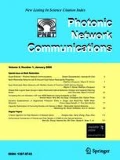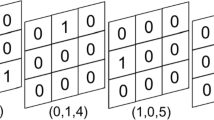Abstract
A new family of two-dimensional variable-weight and constant-length optical orthogonal codes (2D VWOOCs) is proposed, and the code cardinality and BER performance for the corresponding OCDMA system are analyzed in this article. It is shown that the cardinality of 2D VWOOC is larger than that of constant-weight 2D OOC and close to the upper bound in theory. In an OCDMA network, the users employing 2D VWOOC codewords with larger Hamming weight outperform the users using 2D VWOOC codewords with smaller Hamming weight in bit-error-rate performance. Therefore, the OCDMA network employing 2D VWOOC can support diverse quality-of-services (QoS) classes and multimedia services, and make the better use of bandwidth resources in optical networks.
Similar content being viewed by others
Reference
Yang G.C. and Kong W.C. (1997). Performance comparison of multiwave—length CDMA and WDMA+CDMA for fiber-optic networks. IEEE Trans. Commun. 45(11): 1426–1434
Tancevski L., Andonovic I., Tur M. and Budin J. (1996). Hybrid wavelength hopping/time spreading code division multiple access systems. Proc. Inst Elect. Eng. Optoelectron. 143(3): 161–166
Kong W.C., Yang G.C., Baby V., Bres C.-S. and Prucnal P.R. (2005). Multiplewavelength optical orthogonal codes under prime-sequence permutations for optical CDMA. IEEE Trans. Commun. 53(1): 117–123
Sun S., Yin H., Wang Z. and Xu A. (2006). A new family of 2D optical orthogonal codes and analysis of its performance in optical CDMA access networks. J. Lightw. Technol. 24(4): 1646–1653
Wenhua M. (1996). The Theory of Code Construction for Frequence-Hopping Communications, vol. 1. Nat. Defense Industry, Beijing, China, 82–95
Yang G.-C. (1996). Variable-weight optical prthogonal codes for CDMA networks with multiple performance requirements. IEEE Trans. Commun. 44(1): 47–55
Kwong, W.C., Yang, G.-C.: Multiple-length multiple- wavelength optical orthogonal codes for optical CDMA systems supporting multi-rate multimedia services. IEEE J. SAC 22(9), (2004)
Author information
Authors and Affiliations
Corresponding author
Rights and permissions
About this article
Cite this article
Liang, W., Yin, H., Qin, L. et al. A new family of 2D variable-weight optical orthogonal codes for OCDMA systems supporting multiple QoS and analysis of its performance. Photon Netw Commun 16, 53–60 (2008). https://doi.org/10.1007/s11107-008-0117-2
Received:
Accepted:
Published:
Issue Date:
DOI: https://doi.org/10.1007/s11107-008-0117-2




